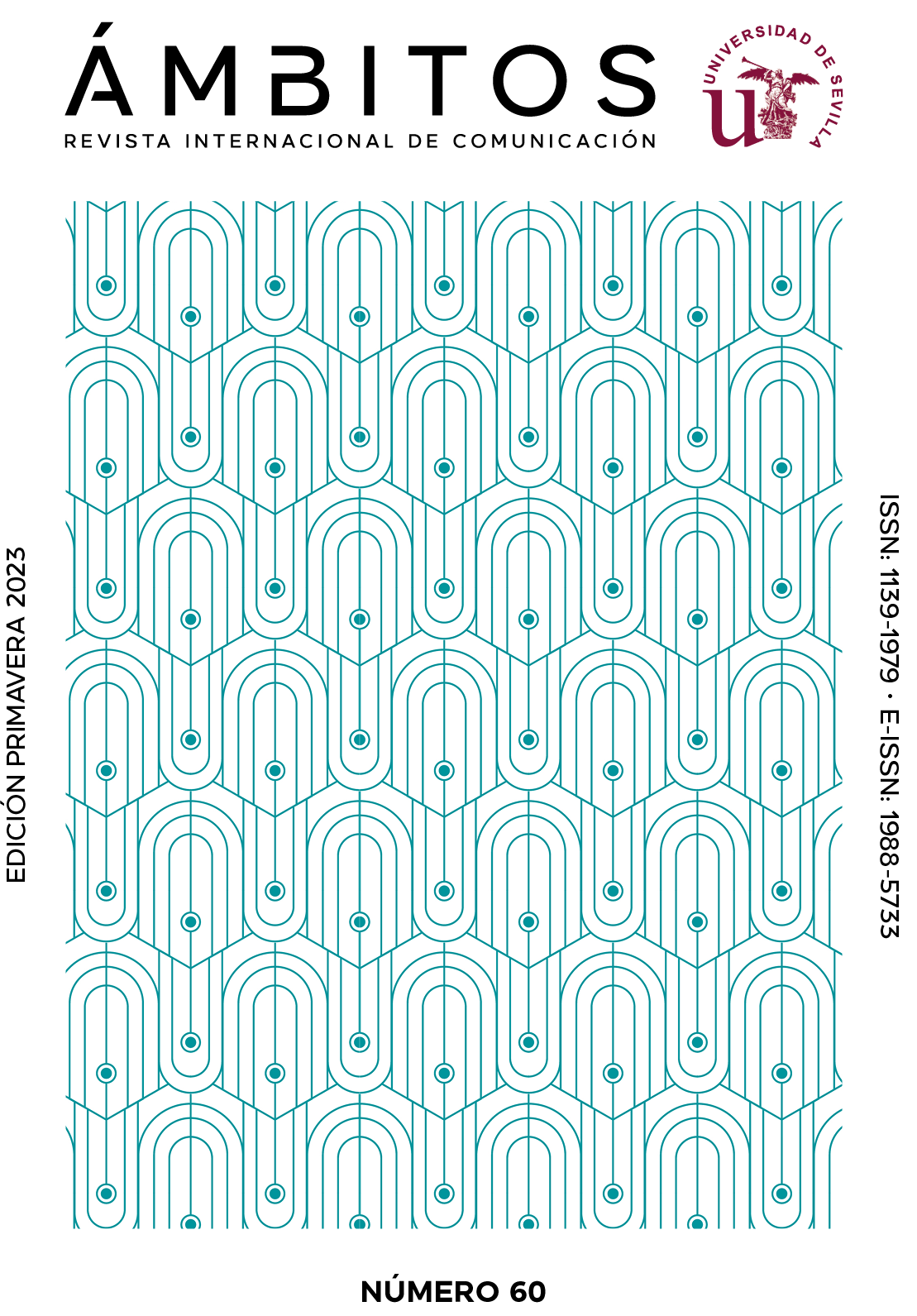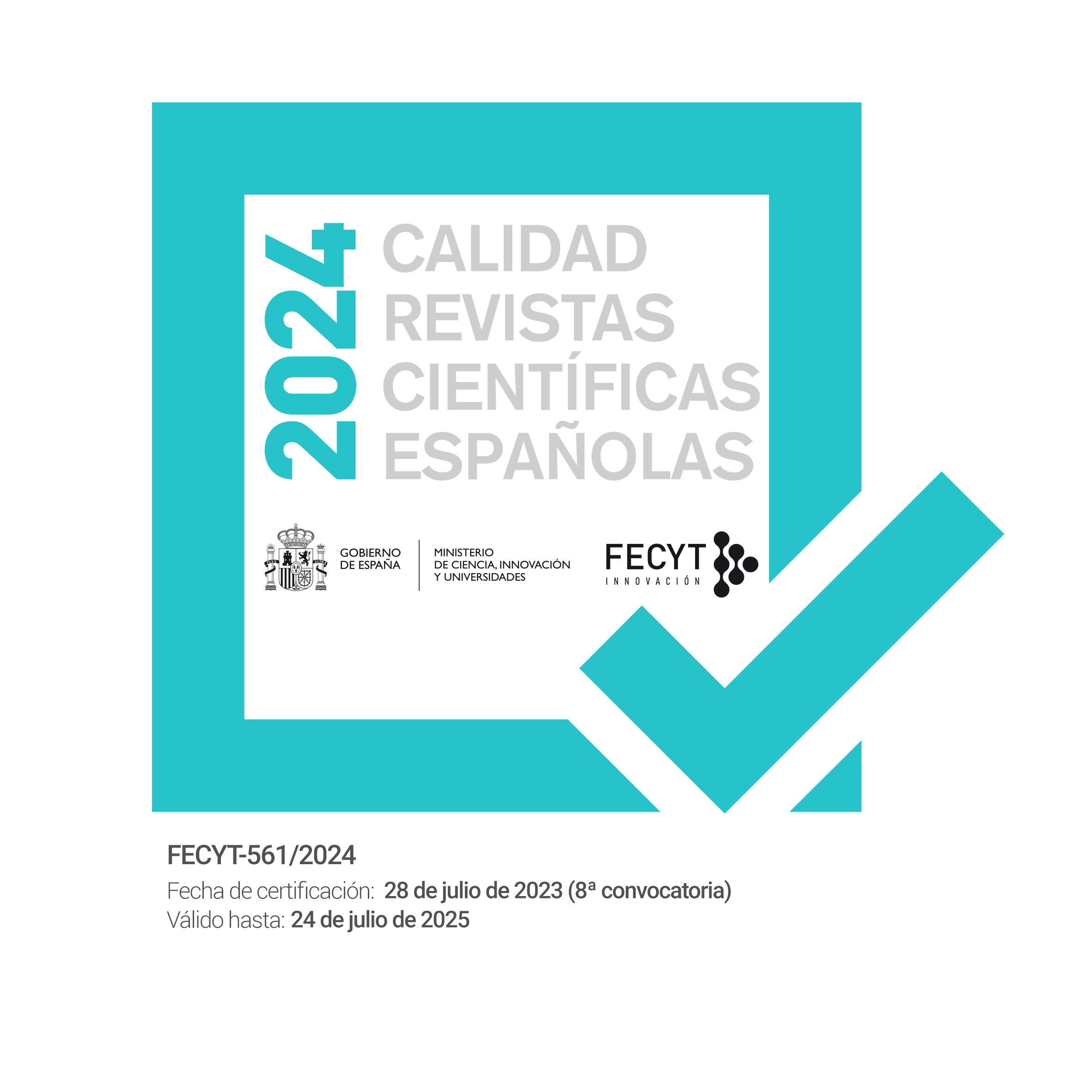Fact-checking journalism in vertical format: multimedia narratives of fact-checkers on TikTok
DOI:
https://doi.org/10.12795/Ambitos.2023.i60.01Keywords:
content analysis, multimedia storytelling, digital journalism, TikTok, fact-checkingAbstract
Fact-checking accounts created by fact-checkers on social networks such as TikTok contribute to responding to two of the main challenges that journalistic activity currently encounters: the phenomenon of disinformation and the influence of social media in spreading fake news. This article analyzes the narratives built by fact-checking journalism on TikTok social network, characterized by short videos in vertical format. The main objective of the research is to understand the multimedia characteristics of the verifiers’ discourses on the social network, as well as the identification of the main challenges and opportunities that narratives of verification face on TikTok. A content analysis is applied that combines qualitative techniques with descriptive statistics. In order to process the analysis, discursive multimedia storytelling categories are established. The results show that the decisions regarding the focus on the topics and the use of multimedia and interactive language configure differentiated fact-checker profiles. The research concludes that the alliance of forces between fact-checking journalism and TikTok social network can be an instrument of great value for the digital literacy of society.
Downloads
References
Albaladejo, T. (2011). Accesibilidad y recepción en el discurso digital: la galaxia de discursos desde el análisis interdiscursivo. En F. Vilches (Coord.). Un nuevo léxico en la red, (pp. 15-28). Universidad Rey Juan Carlos.
Alonso-López, N., Sidorenko-Bautista, P., & Giacomelli, F. (2021). Beyond challenges and viral dance moves: TikTok as a vehicle for disinformation and fact-checking in Spain, Portugal, Brazil, and the USA. Anàlisi: Quaderns de Comunicació i Cultura, 64, 65-84.
https://doi.org/10.5565/rev/analisi.3411
Banks, A., Calvo, E., Karol, D., & Telhami, S. (2021). #PolarizedFeeds: Three Experiments on Polarization, Framing, and Social Media. The International Journal of Press/Politics, 26(3), 609-63.
https://doi.org/10.1177/1940161220940964
Barrios-Rubio, A. y Gutiérrez-García, M. (2021). Prácticas juveniles de consumo sonoro, entre grandes plataformas y el ecosistema radiofónico: Caso Colombia-España. Comunicación y Sociedad, 18, 1-24.
https://doi.org/10.32870/cys.v2021.7820
Becerra-Chauca, N. y Taype-Rondan, A. (2020). TikTok: ¿una nueva herramienta educativa para combatir la COVID-19? Acta Médica Peruana, 37(2), 249-251.
https://doi.org/10.35663/amp.2020.372.998
Boulianne, S., & Theocharis, Y. (2020). Young people, digital media, andengagement: A meta-analysisofresearch. Social Science Computer Review, 38(2), 111-127.
https://doi.org/10.1177/0894439318814190
Casalmiglia, H. y Tusón, A. (1999). Las cosas del decir. Ariel.
Cárdenas Rica, M. L., Mancinas-Chávez, R. y Figuereo-Benítez, J. C. (2022). Transparencia pública para la verificación de datos. El caso de Maldito Dato (Maldita.es). Textual & Visual Media, 1(16), 22-43.
https://doi.org/10.56418/txt.16.2022.002
Castillo-Abdul, B., Romero-Rodríguez, L. M., & Larrea-Ayala, A. (2020). Kid influencers in Spain: Understanding the themes they address and preteens’ engagement with their YouTube channels. Heliyon, 6(9), e05056.
https://doi.org/10.1016/j.heliyon.2020.e05056
Chou, W.-S., Gaysynsky, A., & Vanderpool, R. C. (2021). The COVID-19 Misinfodemic: Moving beyond fact-checking. Health Education & Behavior, 48(1), 9-13.
https://doi.org/10.1177/1090198120980675
Colle, R. (2011). El análisis de contenido en las comunicaciones. Sociedad Latina de Comunicación Social.
Comisión Europea (2018). Flash Eurobarometer 464. Fake news and disinformation online. https://bit.ly/3eQinYv
Comisión Europea (2022). Final report of the Commission expert group on tackling disinformation and promoting digital literacy through education and training: final report. Publications Office of the European Union. https://bit.ly/3jFueLI
Díaz Noci, J. y Salaverría, R. (2003). Manual de redacción ciberperiodística. Ariel.
Díaz Noci, J. (2004). Los géneros ciberperiodísticos. Una aproximación teórica a los cibertextos. [conferencia]. En II Congreso Iberoamericano de Periodismo Digital en Santiago de Compostela.
De Santiago-Guervós, J. (2005). Principios de comunicación persuasiva. ArcoLibros.
Ditrendia (2020). Mobile en España y en el Mundo 2020. https://bit.ly/3iY6iwV
Escandell, M. V. (2004). Aportaciones de la pragmática. En J. Sánchez Lobato y I. Santos Gargallo (Eds.). Vademécum para la formación de profesores. Enseñar español como segunda lengua (L2) / lengua extranjera (LE), (pp. 179-197). SGEL.
Figuereo-Benítez, J. C., Oliveira, J. S. d. y Mancinas-Chávez, R. (2022). TikTok como herramienta de comunicación política de los presidentes iberoamericanos. En J. I. Aguaded Gómez, A. Vizcaíno Verdú, Á. Hernando Gómez, & M. Bonilla-del-Río (Eds.), Redes sociales y ciudadanía: Ciberculturas para el aprendizaje (pp. 103-112). Grupo Comunicar Ediciones.
INJUVE [Instituto de la Juventud]. (2021). Informe Juventud en España (2020). Instituto de la Juventud. https://bit.ly/3XfTWEd
Insider Intelligence. (2022). TikTok users worldwide (2020-2025). Insider intelligence. http://bit.ly/3DRrrpo
IFCN [International Fact Checking Network] (2020). What does it take to be a signatory? http://bit.ly/3YnjDnc
Keenan, C. (2022). An update on our work to counter misinformation. TikTok. http://bit.ly/3HJhagd
Krause, N. M., Freiling, I., Beets, B., & Brossard, D. (2020). Fact-checking as risk communication: The multi-layered risk of misinformation in times of COVID-19. Journal of Risk Research, 23(7-8), 1052-1059.
https://doi.org/10.1080/13669877.2020.1756385
Larrondo-Ureta, A. (2009). La metamorfosis del reportaje en el ciberperiodismo: Concepto y caracterización de un nuevo modelo narrativo. Communicatio Socialis, 22(2), 59-88.
https://doi.org/10.15581/003.22.36258
Lewandowsky, S., Ecker, U. K. H., & Cook, J. (2017). Beyond misinformation: Understanding and coping with the “post-truth” era. Journal of Applied Research in Memory and Cognition, 6(4), 353-369.
https://doi.org/10.1016/j.jarmac.2017.07.008
Li, Y., Guan, M., Hammond, P., & Berrey, L. E. (2021). Communicating COVID-19 information on TikTok: A content analysis of TikTok videos from official accounts featured in the COVID-19 information hub. Health Education Research, 36(3), 261-271.
https://doi.org/10.1093/her/cyab010 PubMed
Loosen, W., Reimer, J., & Hölig, S. (2020). What journalists want and what they ought to do (in)congruences between journalists’ role conceptions and audiences’ expectations. Journalism Studies, 21(12), 1744-1774.
https://doi.org/10.1080/1461670X.2020.1790026
Manovich, L. (2005). El lenguaje de los nuevos medios de comunicación. La imagen en la era digital. Paidós.
Martín Algarra, M. (1995). El Análisis de contenido en la investigación sobre comunicación. Periodística: revista acadèmica, 8, 67-74. https://bit.ly/3DRrZeW
Martínez Valerio, L. (2023). Mensajes misóginos en los perfiles de TikTok de la prensa española: Estudio y percepción por parte de los jóvenes. Ámbitos. Revista Internacional De Comunicación, 59, 110-126.
https://doi.org/10.12795/Ambitos.2023.i59.08
Mitchell, A., Gottfried, J., Stocking, G., Walker, M., & Fedeli, S. (2019). Many Americans say made-up news is a critical problem that needs to be fixed. Error! Peer Research Center. https://pewrsr.ch/3QNWWEu
Morejón-Llamas, N. (2023). Política española en TikTok: Del aterrizaje a la consolidación de la estrategia comunicativa. Revista Prisma Social, (40), 238-261. https://revistaprismasocial.es/article/view/4833
Newman, N., Fletcher, R., Robertson, C. T., Eddy, K., & Nielsen, R. K. (2022). Digital News Report 2022. Reuters Institute. https://bit.ly/3HHVrp4
Paulussen, S., Domingo, D., Heinonen, A., Singer, J., Quandt, T., & Vujnovic, M. (2008). Citizenparticipation in online newsmedia. An overview of current developments in four European countries and the United States. En T. Quandt & W. Schweiger (Eds.), Journalismus online-Partizipation oder Profession? (pp 263-283) VS Verlag für Sozialwissenschaften.
https://doi.org/10.1007/978-3-531-91094-9_18
Pérez-Escoda, A., y Pedrero Esteban, L. M. (2021). Retos del periodismo frente a las redes sociales, las fake news y la desconfianza de la generación Z. Revista Latina de Comunicación Social, 79, 67-85.
https://doi.org/10.4185/RLCS-2021-1519
Robledo Dioses, K., Atarama Rojas, T. y Palomino Moreno, H. (2017). De la comunicación multimedia a la comunicación transmedia: Una revisión teórica sobre las actuales narrativas periodísticas. Estudios sobre el Mensaje Periodístico, 23(1), 223-240.
https://doi.org/10.5209/ESMP.55593
Roca, M. (2008). Rethinking entertainment. Entrevista a Marty Kaplan. Trípodos, 23, 135-143. https://www.raco.cat/index.php/Tripodos/article/view/118924
Rodríguez Pérez, C. (2019). No diga fake news, di desinformación: Una revisión sobre el fenómeno de las noticias falsas y sus implicaciones. Comunicación (Cartago), 40, 65-74.
https://doi.org/10.18566/comunica.n40.a05
Rodríguez Pérez, C. (2020). Una reflexión sobre la epistemología del fact-checking journalism: Retos y dilemas. Revista de Comunicación, 19(1), 243-258.
https://doi.org/10.26441/RC19.1-2020-A14
Romero-Rodríguez, L. M., Tejedor, S., & Castillo-Abdul, B. (2022). From the Immediacy of the Cybermedia to the Need for Slow Journalism: Experiences from Ibero-America. Journalism Practice, 16(8), 1578-1596.
https://doi.org/10.1080/17512786.2020.1870530
Salaverría, R. (2004). Cómo escribir para la prensa digital? Mediaccion.doc [documento en línea]. Universidad de Navarra.
Salaverría, R. (2005). Cibermedios: El impacto de Internet en los medios de comunicación en España. Comunicación Social Ediciones y Publicaciones y Sociedad.
Salaverría, R. (2014). Multimedialidade: informar para cinco sentidos. En J. Canavilhas (Org.), Webjornalismo:7 caraterísticas que marcam a diferença (pp. 25-52). Livros LabCom.
Sánchez-García, P., & Salaverría, R. (2019). Multimedia news storytelling: Semiotic-narratological foundations. El Profesional de la Información, 28(3), 280-303.
https://doi.org/10.3145/epi.2019.may.03
Scolari, C. (2004). Hacer clic. Hacia una sociosemiótica de las interacciones digitales. Gedisa.
Shapiro, G., & Markoff, J. (1997). A matter of definition. En C. W. Roberts (Ed.), Text Analysis for the Social Sciences: Methods for Drawing Statistical Inferences from Texts and Transcripts (pp. 9-31). Lawrence Erlbaum.
Sidorenko-Bautista, P., Alonso-López, N., & Giacomelli, F. (2021). Fact-checking in TikTok. Communication and narrative forms to combat misinformation. Revista Latina de Comunicación Social, 79, 87-113.
https://doi.org/10.4185/RLCS-2021-1522
Sidorenko-Bautista, P., Herranz, J. M., & Cantero, J. I. (2020). Use of new narratives for COVID-19 reporting: From 360º videos to ephemeral TikTok videos in online media. Trípodos, 1(47), 105-122.
https://doi.org/10.51698/tripodos.2020.47p105-122
Tobeña, V. (2020). Pensar el futuro de la escuela desde comunidades de prácticas. Claves desde TikTok. Dilemata, (33), 221-233.
Van Dijk, T. A. (1996). Estructuras y funciones del discurso. Siglo XXI.
Vásquez, H. J., Negreira, R. M. C., & López, G. X. (2022). Let’s dance the news! How the news media are adapting to the logic of TikTok. Journalism, 23(8), 1717-1735.
https://doi.org/10.1177/1464884920969092
Vosoughi, S., Rpy, D., & Aral, S. (2018). The spread of true and false news online. Science, 359(6380), 1146-1151.
https://doi.org/10.1126/science.aap9559
Feng, Y. -L., Chen, C. -C., & Wu, S. -M. (2019). Evaluation of charm factors of short video user experience using FAHP-a case study of TikTok app. IOP Conference Series. Materials Science and Engineering, 688(5), 055068.
Downloads
Published
How to Cite
Issue
Section
License
Copyright (c) 2023 Carolina Arrieta-Castillo, Ana Virginia Rubio Jordán

This work is licensed under a Creative Commons Attribution-NonCommercial-ShareAlike 4.0 International License.
Ámbitos. Revista Internacional de Comunicación is an open access journal, which means that all content is freely available at no charge to the user or their institution. Users may read, download, copy, distribute, distribute, print, search or link to the full text of articles, or use them for any other lawful purpose, without seeking prior permission from the publisher or author. This definition of open access is in accordance with the Budapest Open Access Initiative (BOAI).

Unless otherwise noted, all content in the electronic edition is distributed under a "Creative Commons Attribution-NonCommercial-ShareAlike 4.0 International License". You can consult the informative version and legal text of the licence here. This should be expressly stated in this way where necessary.
In case of acceptance of the manuscript, the authors cede the rights of the work for its publication to Ámbitos. Revista Internacional de Comunicación under the Attribution-NonCommercial-ShareAlike 4.0 International license contract (CC BY-NC-SA 4.0). The authors retain copyright and third parties are authorised to copy, distribute and make use of the work, provided they comply with the terms and conditions set out in the licence
- Cite the authorship and the original source of publication (journal, publisher and URL of the work).
- Do not use them for commercial purposes.
- If you remix, transform or create from the material, you must release your contributions under the same license as the original.
More information can be found at https://creativecommons.org/licenses/by-nc-sa/4.0/deed.es


















